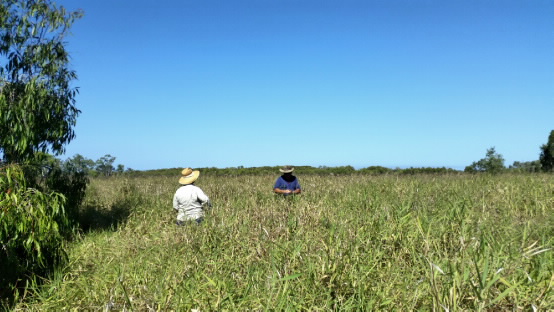Media Releases
New project put Insulator Creek in the spotlight for World Wetlands Day

James Cook University staff and students will be among those working on the land after more than $100,000 was granted to fix a degraded wetland between Townsville and Cairns.
Insulator Creek will be transformed over the next three years, from a weed-choked waterway into a valuable mahogany glider and fish habitat.
The state government will provide $90,000 towards the work, to restore 40 hectares of wetland habitat at the bottom end of Insulator Creek, and control the invasive weed Hymenachne (marsh grasses) and feral pigs.
The Herbert River Catchment Group has granted another $20,000 fix a large washout just upstream of the Bruce Highway. A consultant will work to design and construct an ecologically sensitive solution to the erosion problem.
James Cook University, Nywaigi Traditional Owners, Terrain NRM, Paluma Environmental Education Centre and the Department of Agriculture, Fisheries and Forestry will monitor and deliver work on the ground. Members of the Herbert River Catchment Group and Hinchinbrook Wetlands Alliance will oversee the projects.
JCU’s Professor Marcus Sheaves is a founding member of the Hinchinbrook Wetlands Alliance and is looking forward to getting university students involved in the wetland restoration project. “The grass-sedge wetlands at the downstream end of Insulator Creek were once high value fish nurseries which, like many of our coastal wetlands, have been overrun by Hymenachne,” he said. “The invasion by Hymenachne has rendered the area uninhabitable by all but a few hardy fish species, resulted in poor water quality and changed the fire regime in the area.”
He said students will be involved in monitoring the site during the project to observe how the habitat recovers. “We also intend on using underwater video to see what fish are living in the creek before, during and after the project.” Professor Sheaves said.
The two projects will commence in mid-2015 and opportunities for community involvement will be advertised in local newspapers and community newsletters.
Terrain NRM Community Partnerships officer, Jacqui Richards said “local landholders, school children and the community will have the opportunity to visit these sites, learn more about what makes Insulator Creek so special and get their hands dirty tackling weeds and planting trees.”
“These projects will bring together a number of groups to work collaboratively to reinstate the ecological and cultural values of Nywaigi country, share knowledge and raise the profile of our wetlands.” she said.
Contact: Professor Marcus Sheaves.
E: Marcus.sheaves@jcu.edu.au
P: 07 4781 4144
World Wetlands Day is celebrated internationally each year on 2 February. It marks the anniversary of the signing of the Convention on Wetlands of International Importance in Ramsar, Iran, on 2 February 1971.
The Ramsar Convention Secretariat has developed a number of downloadable World Wetlands Day materials for 2015, including a teaching guide, handouts, posters and fact sheets. These materials can be found on the Ramsar Convention Secretariat’s World Wetlands Day 2015 website (link is external). Groups and individuals are encouraged to adapt these materials for their own World Wetlands Day events and activities.